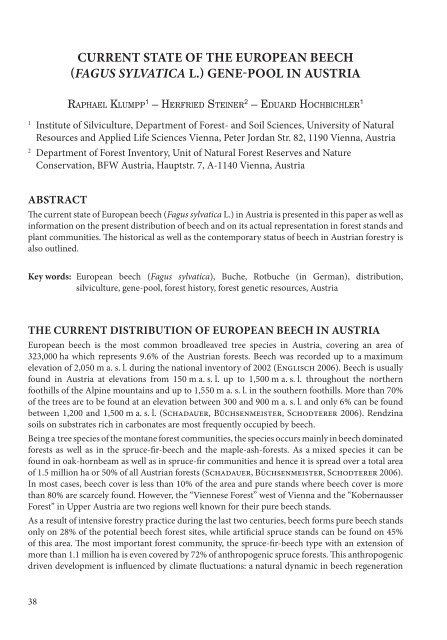Create successful ePaper yourself
Turn your PDF publications into a flip-book with our unique Google optimized e-Paper software.
38<br />
curreNT sTaTe oF The euroPeaN beech<br />
(Fagus sylvatica L.) GeNe-PooL IN ausTrIa<br />
RAPHAEL KLUMPP 1 – HERFRIED STEINER 2 – EDUARD HOCHBICHLER 1<br />
1 Institute of Silviculture, Department of Forest- and Soil Sciences, University of Natural<br />
Resources and Applied Life Sciences Vienna, Peter Jordan Str. 82, 1190 Vienna, Austria<br />
2 Department of Forest Inventory, Unit of Natural Forest Reserves and Nature<br />
Conservation, BFW Austria, Hauptstr. , A-1140 Vienna, Austria<br />
absTracT<br />
The current state of European beech (Fagus sylvatica L.) in Austria is presented in this paper as well as<br />
information on the present distribution of beech and on its actual representation in forest stands and<br />
plant communities. The historical as well as the contemporary status of beech in Austrian forestry is<br />
also outlined.<br />
Key words: European beech (Fagus sylvatica), Buche, Rotbuche (in German), distribution,<br />
silviculture, gene-pool, forest history, forest genetic resources, Austria<br />
The curreNT dIsTrIbuTIoN oF euroPeaN beech IN ausTrIa<br />
European beech is the most common broadleaved tree species in Austria, covering an area of<br />
323,000 ha which represents 9.6% of the Austrian forests. Beech was recor<strong>de</strong>d up to a maximum<br />
elevation of 2,050 m a. s. l. during the national inventory of 2002 (Englisch 2006). Beech is usually<br />
found in Austria at elevations from 150 m a. s. l. up to 1,500 m a. s. l. throughout the northern<br />
foothills of the Alpine mountains and up to 1,550 m a. s. l. in the southern foothills. More than 0%<br />
of the trees are to be found at an elevation between 300 and 900 m a. s. l. and only 6% can be found<br />
between 1,200 and 1,500 m a. s. l. (Schadauer, Büchsenmeister, Schodterer 2006). Rendzina<br />
soils on substrates rich in carbonates are most frequently occupied by beech.<br />
Being a tree species of the montane forest communities, the species occurs mainly in beech dominated<br />
forests as well as in the spruce-fir-beech and the maple-ash-forests. As a mixed species it can be<br />
found in oak-hornbeam as well as in spruce-fir communities and hence it is spread over a total area<br />
of 1.5 million ha or 50% of all Austrian forests (Schadauer, Büchsenmeister, Schodterer 2006).<br />
In most cases, beech cover is less than 10% of the area and pure stands where beech cover is more<br />
than 80% are scarcely found. However, the “Viennese Forest” west of Vienna and the “Kobernausser<br />
Forest” in Upper Austria are two regions well known for their pure beech stands.<br />
As a result of intensive forestry practice during the last two centuries, beech forms pure beech stands<br />
only on 28% of the potential beech forest sites, while artificial spruce stands can be found on 45%<br />
of this area. The most important forest community, the spruce-fir-beech type with an extension of<br />
more than 1.1 million ha is even covered by 2% of anthropogenic spruce forests. This anthropogenic<br />
driven <strong>de</strong>velopment is influenced by climate fluctuations: a natural dynamic in beech regeneration

















